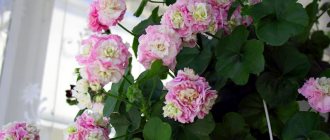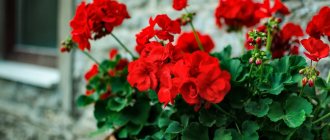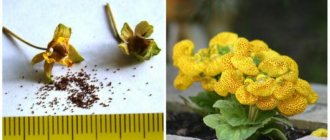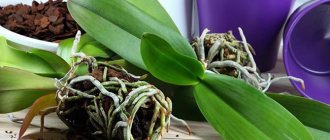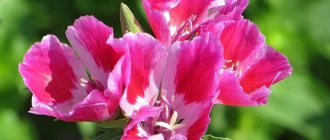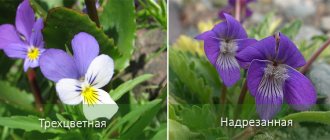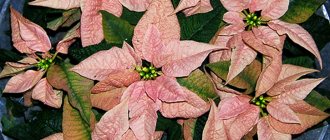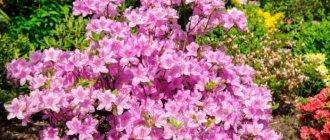How to propagate
There are two ways to propagate Simon group pelargoniums: cuttings and seeds. In the first case, all varietal characteristics of the mother bush are preserved, in the second, the grower receives completely new plants.
Cuttings
Many beautiful pelargoniums of this variety are hybrids, which means they can only be propagated at home by cuttings.
We plant cuttings like this:
- after trimming the bush, select shoots suitable for planting;
- cut them at a 45 degree angle;
- wait a while until the cut is covered with a film - it stops releasing juice and becomes dull;
- plant the cuttings in plastic cups filled with pre-sterilized moist soil;
- leave the plants to take root in a shaded place until the first leaves appear;
- After the greenery appears, take the plants to a bright place without direct sunlight.
Seeds
Representatives of "Salmon", which are not hybrids, grow well from seeds, retaining all the original characteristics of their variety.
Plant the seeds as follows:
- Pre-wet the seeds in water or rub with sandpaper - this will help the sprouts hatch faster;
- place the sterilized soil in a container;
- we plant the seeds at a distance of 3-5 cm from each other in moist soil;
- gently crush each seed with your finger;
- cover with a thin layer of soil;
- cover the container with film and transfer to a dark place;
- after germination, we bring the plants into the light;
- every day we peel back the film to ventilate the seedlings;
- if the ground is wet, there is no need to spray the soil - waterlogging can lead to the death of crops, as can irregular watering;
- With the appearance of the first two true leaves, the sprouts are transplanted into individual cups.
Be attentive to these wonderful plants, and they will thank you with lush and beautiful flowering.
Features of care
Let's find out how to care for Pak pelargonium so that it grows well and pleases the eye with lush flowering.
Watering
For successful growth and flowering, the plant needs regular watering, but without waterlogging. It is recommended to moisten the soil only when the top layer of the substrate has dried. After flowering in the fall, the frequency and abundance of watering is reduced so that the plant stops its rapid growth and prepares for hibernation.
Top dressing
This plant does not need frequent feeding.
It is only important to feed pelargonium in the spring with nitrogenous compounds to form abundant green mass, and before flowering, add potassium and phosphorus for a more abundant formation of inflorescences. It is advisable to introduce additional nutrition in liquid form along with. Important! In winter, the plant is not fed, since during this period pelargonium rests and recovers, preparing for the next growing season
If you are propagating a plant, then after rooting the cuttings it is very important to feed them with nitrogen compounds so that young pelargoniums gain green mass faster
Important! In winter, the plant is not fed, since during this period pelargonium rests and recovers, preparing for the next growing season. If you are propagating a plant, then after rooting the cuttings it is very important to feed them with nitrogenous compounds so that young pelargoniums gain green mass faster. If you are propagating a plant, then after rooting the cuttings it is very important to feed them with nitrogen compounds so that young pelargoniums gain green mass faster
If you are propagating a plant, then after rooting the cuttings it is very important to feed them with nitrogen compounds so that young pelargoniums gain green mass faster
Trimming
Since this type of pelargonium grows quite quickly, the formation of a bush is necessary in this case. If pruning is not done in time, the inflorescences will become smaller and the bush will lose most of its decorative effect. Old shoots that have outlived their usefulness must be removed regularly, and young shoots must also be pinched so that more active lateral branching occurs.
Wintering
Pelargonium Pak is best wintered not in a warm room, but on a glassed-in veranda, loggia or greenhouse. At night the temperature in this room should be approximately +6 degrees, during the day it should rise to +12-15 degrees. This is the optimal temperature for a successful wintering of the flower.
Note that if the pelargonium variety is bicolor or tricolor, then it is better to keep the flower in a warmer room, since these varieties are more delicate. Do not place pots with plants too closely, since such thickening in conditions of fairly low temperatures and high humidity is fraught with the spread of fungal diseases and rot. Pak pelargonium needs to be watered extremely sparingly in winter, and only if the top layer of the substrate has dried out considerably.
Description of varieties
Among the varieties of pelargonium of the Elnaruds series, there are the most common ones.
Hilda
Compact pelargonium with lush double buds of uneven pink and white color. The leaves are yellow with a brown spot in the middle. Hilda tolerates heat well and has a long flowering period.
Pelargonium anita (anita)
Gusten
A vigorously flowering variety of pelargonium Elnaryds. The inflorescences are dense, the buds are peachy-pink. The bush has a compact shape.
Variety Gusten
Bente
Zonal pelargonium. It reaches a height of 10 cm. The inflorescences are lush and double. The buds are apricot-red. Flowering of this species begins in May and continues until the end of September.
Bente flower
Otto
Otto is often used to decorate balconies and verandas. The buds of this variety are orange in color, gradually turning into soft pink. The bush reaches a height of 10 cm. Flowering begins in late spring.
A variety of flower called Otto
Names of flowers for creating a balcony flower garden photo
Singoalla
House plant with white, slightly pinkish flowers. The bush is compact and easy to shape.
Pelargonium Singoalla
Lilian
A dwarf plant with double voluminous inflorescences. The buds can be bluish-lavender in spring and pink in summer.
Representative of the Lilian variety
Clarissa
Lush bush with snow-white double flowers. The plant is compact and does not require formation.
Clarissa flower
How to plant, care for and propagate April Snow pelargonium? possible pests and diseases
Description
Pelargonium Pak (PAC) are hybrid plant varieties distinguished by their magnificent appearance and unique decorative qualities. The varieties are among the most popular today, which is not surprising: along with the stunning external effectiveness of Pak pelargonium, they are also unpretentious in care and grow well even with novice flower growers.
On a note. The cost of a rooted cutting of one of the Pak varieties today is about 500 rubles.
This hybrid is not propagated by seeds at home, since often the plants in this case do not inherit valuable parental qualities. Note that pelargonium Pak is a new word in floriculture, and the varieties were created quite recently.
However, at the very first exhibition, these plants immediately attracted all the attention and immediately earned universal recognition and love. These varieties are intended for landscape gardening, therefore they are distinguished by their unpretentious “character” and are able to withstand rather harsh external conditions
Appearance and characteristics of pelargoniums
There are about 250 varieties of Pelargonium Toscana. The most favorite plants of gardeners are Bernd pelargonium, Regina species, Tammo and others.
The stem of the flower can be straight or curly, and the leaves can be carved and terry. But the defining characteristic feature is the inflorescences themselves - bright or soft pink flowers of 4 petals, which are collected together into a bouquet.
Royal pelargonium is valued for the unusual color of its semi-double petals.
This is interesting! Sometimes in descriptions the flower is called “Tuscan geranium”, but this is wrong, pelargonium just belongs to the geranium genus.
Other popular varieties of pelargonium from the Odensjo series
Symphony pelargonium has a number of varietal representatives, among which you can choose a plant based on color and type of flowering. The most popular varieties:
Sound of Silence. Pelargonium Odencio species Sound Silence grows slowly, the bush is compact, and the flowers are distinguished by a delicate white color with a greenish tint. The crop should be watered carefully because it has a small root system. Suzie Wong. Susie Wong differs from the Odencio standard in the deeper and richer pink color of the double petals. Rodluvan. It has bright red flowers, bushes well, and does not require frequent pruning. The variety is characterized by voluminous inflorescences, which makes it luxurious. Bernadette. One of the most delicate flowers of light pink pastel. The plant belongs to the dwarf species. Hummingbirds Egg Butterfly
The subspecies with an intricate name attracts attention with its rich lilac-pink color. Large flowers contrast with variegated green leaves. Ice Frozen Campari
Zonal pelargonium stands out with lilac flowers, which complement the bright inclusions on the petals and the core. Lynn Palmer. The flower is suitable for growing in pots. Petals are semi-double with a color gradient from white to purple and green. Madame Bovary. Bovary attracts attention with its expressively bright red color. Inflorescences are collected in large bouquets. Stilla Flirt. The smallest and most elegant variety from Odensio. The soft pink color is reminiscent of the gold standard of this type of pelargonium.
Pelargonium Bernadette perfectly reveals and complements the main view
Recipe for “Salmon with scallops “A la Narcissus””:
Place 1 cup of rice with two cups of water, a pinch of salt and 1 teaspoon of vegetable oil in a microwave-safe vessel with a lid for 20 minutes at full power.
Cut the salmon into 2 parts and place in the 1st row of a steam pan. Pour the juice of half a lemon, salt and pepper to taste.
We take out frozen vegetables (listed above), and if you have fresh ones, cut them and place them on the 2nd floor of a steam pan. Close it and put it on the fire until it all boils. And then lower the heat and leave to simmer.
At this time, take a frying pan and butter. Heat the oil a little so that it does not turn black (otherwise it will interrupt the taste). And fry our scallops over medium heat.
When the scallops are browned, pour in the cream. Let it boil and after it boils, reduce the heat. Let the sauce simmer over low heat. Otherwise it will evaporate, and there will be nothing to pour over the dish. Scallop meat is very tender, so you don’t need to cook it much, the sauce simmered a little, about 5-7 minutes, salt and pepper to taste and that’s it! Remove from the fire!
During this time, our rice was cooked. Vegetables and salmon are also ready. The sauce with scallops does not take much time - just a few minutes. Now you can serve by pouring the sauce over the rice, vegetables and fish. A very easy dish of my invention, and everyone really likes it. Try it, you won't regret it! Bon appetit!
